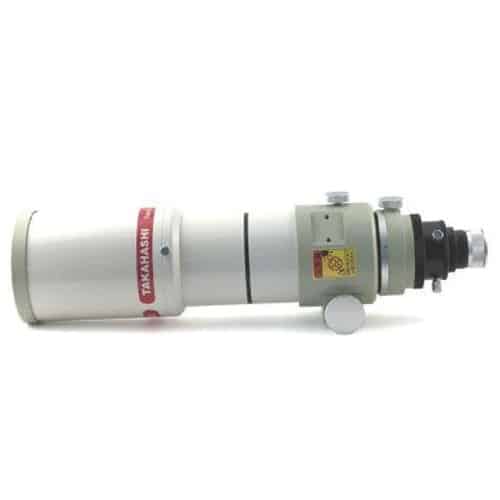We analyzed 100+ images shortlisted for Astronomy Photographer of the Year to find the Best Telescopes for Deep Space Astrophotography.
We found that apochromatic refractors are the most successfully used telescope type:
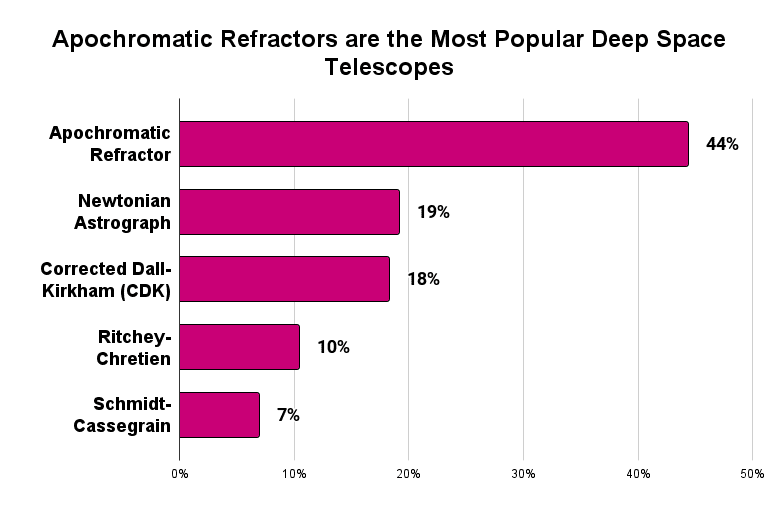
And Takahashi is the most successful manufacturer:
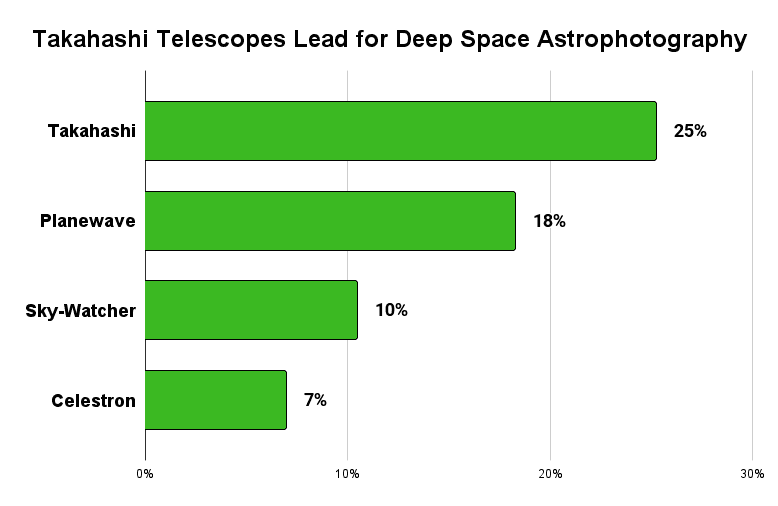
Read on to find out our recommended telescope models and for more detail on the data we have used to make our recommendations.
*This website makes money through affiliate commissions. This means we may be compensated if you click links on this page at no extra cost to you.
Best Telescopes for Deep Space Astrophotography
Quadruplet Petzval Apochromatic Refractor Telescope
- 85mm aperture / 450mm focal length / f/5.3 focal ratio
- Perfect for wide-field deep sky imaging
- Weighs just 8 lbs
- Small & compact for travel
Verdict: Best Apochromatic Refractor Telescope for Deep Space Imaging
Our number one pick is the Takahashi FSQ-85EDX quadruplet apochromatic refractor.
Our results show that Takahashi APOs are the most successfully used deep space astrophotography telescopes. They are known for being extremely high-quality pieces of gear made by the Japanese company.
In addition, this specific model is one of the most successfully used for deep sky imaging in the competition.
The main problem with this is that there is usually very limited availability of Takahashi telescopes and they sell out very quickly when they do become available.
Right now, the Takahashi FSQ-85EDX is available and has all the qualities of a great apochromatic refractor telescope for deep space astrophotography:
- Triplet apochromatic refractor with extra-low dispersion (ED) glass
- Relatively small, light, and compact and so portable and doesn’t require a huge, heavyweight mount to support it
Overall, this is a premium model in a high-price bracket for serious astrophotographers.
Key Specifications of the Takahashi FSQ-85EDX
- Type: Quadruplet Apochromatic Refractor
- Aperture: 85 mm (3.25 inch)
- Focal Length: 450 mm
- Focal Ratio: F/5.3
- Weight: 8 lbs (3.6 kg)
- Size (length): 525 mm
Value Imaging Newtonian Telescope for Astrophotography
- Large 8-inch Aperture
- 800mm Focal Length
- Fast F/4 Focal Ratio
- Great value for the price
Verdict: Best Newtonian Astrograph Telescope for Deep Sky Photography
Our budget pick is the Sky-Watcher Quattro 200P. It is the third most successfully used telescope for deep space astrophotography in our results.
This is an imaging Newtonian astrograph, meaning that it is a variation on a classic Newtonian reflector that is optimized for astrophotography and not viewing.
It is bigger and bulkier than an apochromatic refractor, but its large 8-inch aperture and fast focal ratio of F/4 make it great at capturing the faint light of far-off galaxies and other DSOs.
The downside of a reflector like this versus an apochromatic refractor is the additional size and weight. Whereas APOs are small and light, newtonians are fairly bulky and heavy.
The big upside though is the value for money. Reflectors are always the best in terms of price-to-aperture and are significantly cheaper than apochromatic refractors with similar aperture, focal length, and focal ratio.
You can also buy it as a smaller 6-inch aperture model, as well as larger 10-inch and 12-inch, where you get more aperture at a higher price.
Watch this video from Sky-Watcher for an overview of the Quattro range:
Overall, this is a great option if you value big aperture and value for money over portability.
Key Specifications of the Sky-Watcher Quattro 200P
- Type: Newtonian Astrograph
- Aperture: 203 mm (8-inch)
- Focal Length: 800 mm
- Focal Ratio: F/4
- Weight: 28 lbs
- Size: 28-inch (length)
Ultra-Light Doublet Apochromatic Refractor
- Doublet APO optics
- Wide 360 mm focal length
- Just 3.2 lbs weight
- Great budget option
Verdict: Best Budget Telescope for Deep Space Astrophotography
A great budget apochromatic refractor is the William Optics ZenithStar 61.
It is an ultra-light, ultra-compact doublet APO with a wide focal length.
This gives you the advantages of an APO at a low price and is extremely easy to travel with due to its size and weight.
The downside in comparison to the Takahashi and Sky-Watcher models above is the much smaller aperture.
You can watch an overview here from AstroBackyard where the ZenithStar 61 is put through its paces for deep sky imaging:
Overall, this is a great option if you want the best budget telescope for deep sky astrophotography and value portability over big aperture.
Key Specifications of the William Optics ZenithStar 61
- Type: Doublet Apochromatic Refractor
- Aperture: 61 mm (2.5-inch)
- Focal Length: 360 mm
- Focal Ratio: F5.9
- Weight: 3.2 lbs
- Size: 9-inch (length)
Celestron’s Rowe-Ackermann Schmidt Astrograph (RASA) V2
- Large 11-inch aperture
- Fast F/2.2 focal ratio
- Wide 620 mm focal length
- Coma and field-curvature free
Verdict: Best Celestron Telescope for Deep Space Imaging
Our final recommendation is the Celestron RASA 11 V2.
This is a Rowe-Ackermann Schmidt Astrograph (RASA) telescope that is a variation on the classic Schmidt-Cassegrain optimized for deep sky imaging.
You can watch a brief overview of the RASA range in this video from Celestron:
It is extremely fast at F/2 and has a very large 11-inch aperture for great light gathering. It also has a very long focal length which is great for capturing small DSOs like galaxies.
It corrects for the coma that occurs in imaging with regular Schmidt-Cassegrains and is free of field curvature.
The downsides are:
- Like the Takahashi model above, it is in the more premium price bracket, and
- It is also significantly larger and heavier than an apochromatic refractor
Overall, this is a great option if you want the largest aperture and fastest focal ratio in your telescope for deep sky astrophotography.
It’s in a similar price bracket to premium APOs like the Takahashi above, with the main downside in comparison being the bigger size and additional weight.
Key Specifications of the Celestron RASA 11
- Type: Rowe-Ackermann Schmidt Astrograph (RASA)
- Aperture: 279 mm (11-inch)
- Focal Length: 620 mm
- Focal Ratio: F2.2
- Weight: 43 lbs
- Size: 33-inch (length)
Data: Best Telescope for Deep Sky Astrophotography
For the research in this article, we analyzed the equipment used in 400+ images shortlisted for Astronomy Photographer of the Year (the world’s leading astrophotography competition) for the last four years from 2019 to 2022.
Of the 400+ photos, 145 were of deep sky objects (DSOs) and that is the data we have used in this research.
You can read the full analysis covering cameras and mounts too here, as well as our larger article on the Best Telescopes for Astrophotography covering all astrophotography telescopes, but in this article we have focused on the telescopes used in deep space images.
Below you can see the analysis by:
- Telescope Type
- Telescope Manufacturer
- Telescope Model
Deep Space Telescope Types
We found that the most commonly used types of telescope for deep sky are (in this order):
- Apochromatic Refractors
- Newtonian Astrographs
- Corrected Dall Kirkham (CDK)
- Ritchey-Chrétien
- Schmidt-Cassegrain
- Riccardi-Honders
You can see how it breaks down here:
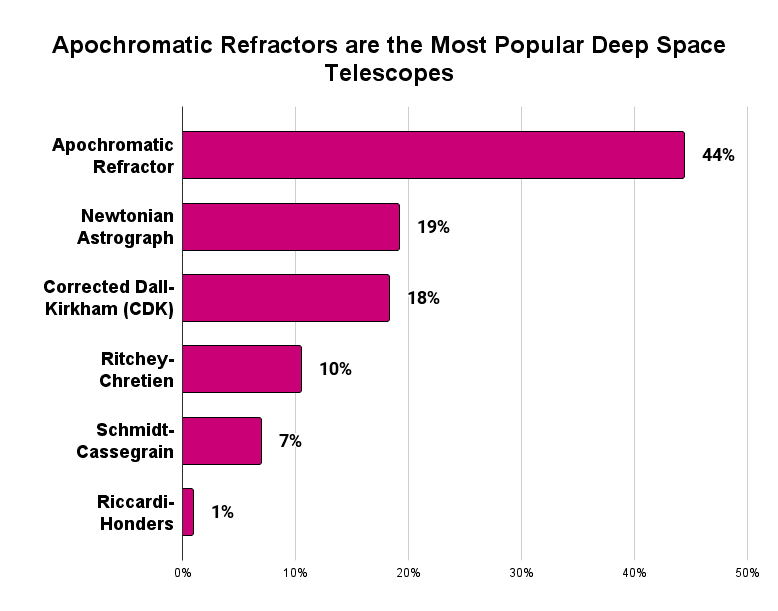
Let’s look at each of these five telescope types to examine the differences:
Apochromatic Refractor
Apochromatic refractors are by some distance the most commonly used telescope type for deep sky photography in our research.
Known as “Apochromats” or just “APOs”, these are telescopes that are optimized for astrophotography by correcting the chromatic aberration that occurs with regular refractors. Chromatic aberration is where a colored fringe appears around bright objects.
Apochromatic refractors can be:
- Doublet – two lenses
- Triplet – three lenses
- Quadruplet – four lenses
- Quintuplet – five lenses
- Sextuplet – six lenses
Generally, the more lenses, the sharper the image will be, but also the more expensive the telescope will be (although this is not the only factor in determining the price).
They often also use extra-low dispersion glass in the lenses which improves imaging. This is abbreviated to ED in many model names.
They tend to have short focal lengths, making them great for wide-field captures of DSOs with high-resolution cameras.
This way of doing DSO imaging has become more popular in recent years as the price of high-resolution cameras has come done. Therefore, rather than needing a long focal length because of a low-resolution camera, you can capture a wider expanse of sky with a short focal length and crop the object you are targeting and still get a quality image.
This also makes capturing the image easier as the shorter focal length is more forgiving of tracking errors that may occur with your mount.
The reasons they have been so successfully used in the best deep sky images are:
- They are tailored for deep sky imaging, as described above
- They are relatively compact, with many models being extremely small, light and portable (although some are bigger)
- They are relatively cheap. Whilst some retail in the thousands of dollars, some high-quality budget models are available for around $500-$600
Newtonian Astrograph
Newtonian Astrographs are a version of the classic reflector telescope tailored for astrophotography.
They typically have fairly large aperture and a fast focal ratio.
The advantages are that they have good astrophotography specifications at a relatively cheap price.
The main disadvantage is that they are fairly big and bulky.
Corrected Dall Kirkham (CDK)
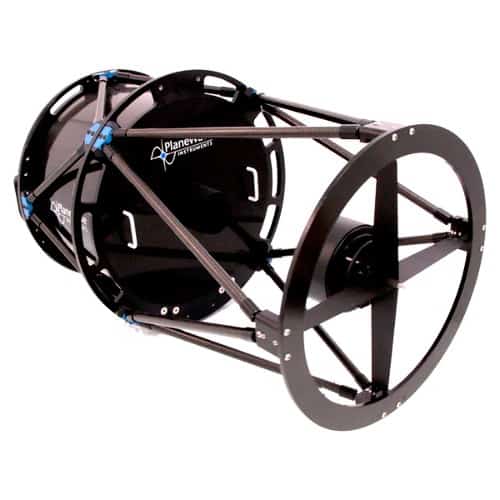
A Corrected Dall Kirkham (CDK) telescope is a modified version of a Dall Kirkham telescope type specifically manufactured by Planewave.
These are premium telescopes that are highly optimized for astrophotography. They are very expensive (in the tens of thousands of dollars) and so are for very serious imagers and researchers.
Ritchey-Chrétien
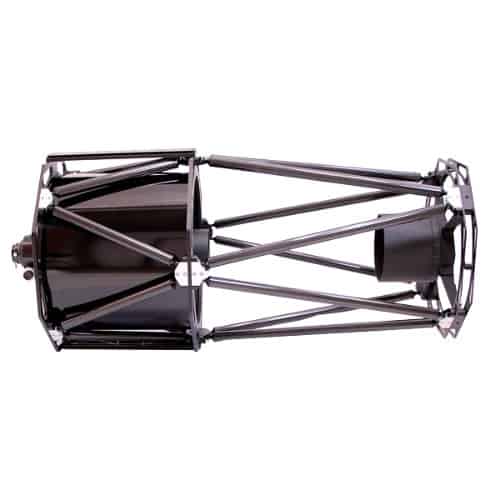
Ritchey-Chrétien (RC) telescopes are another premium deep sky telescope type that is used not only by enthusiastic astrophotographers but also in observatories and research institutions.
They are generally very expensive, although some smaller budget models that used the RC design do exist.
Schmidt-Cassegrain
Schmidt-Cassegrains telescopes (SCT) are a type of compound/catadioptric telescope that are one of the most popular for regular astronomy and astrophotography enthusiasts.
They provide high aperture, with a (usually) long focal length in a compact body.
Celestron is the leading brand for SCTs and sells them as part of packages like the popular Nexstar SE range.
In addition, there are models like the Celestron EdgeHD range that are optimized for deep sky photography by correcting the coma that is inherent in SCTs and can be adapted to have much faster focal ratios.
Riccardi-Honders
The Riccardi-Honders (RH) is another premium, high-end telescope type.
The most prominent maker of RH telescopes today is the Italian manufacturer Officina Stellare.
Deep Space Telescope Manufacturers
Now can look at the most successfully used telescope brands for deep sky photography:
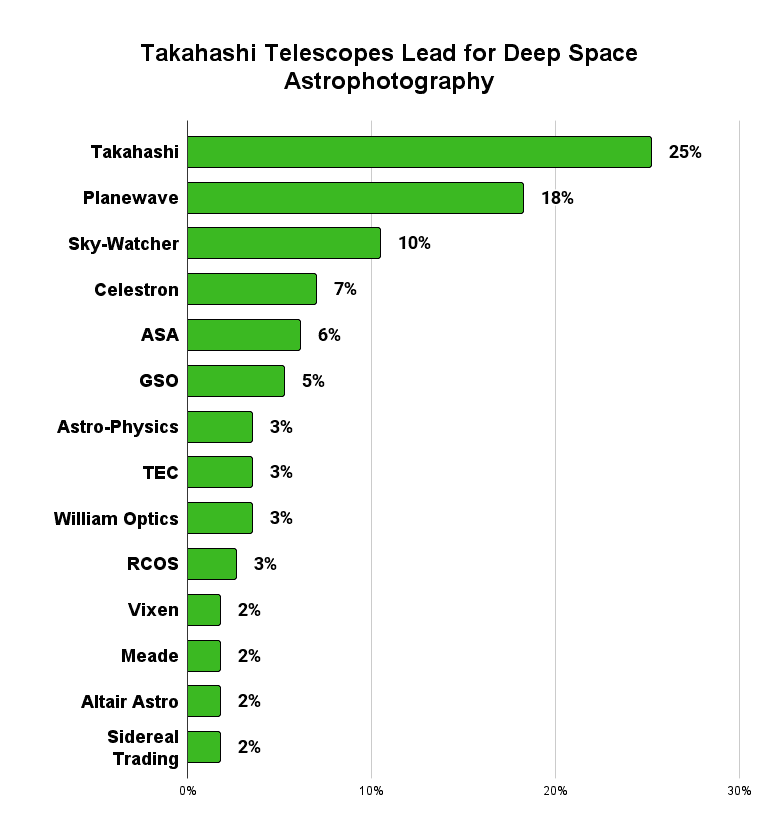
We see Takahashi in first place. They top the list because of the high-quality apochromatic refractors that they make.
In second is Planewave. They make and sell the premium CDKs being used so successfully.
Third goes to Sky-Watcher, who offer some great apochromatic refractors and Newtonian astrographs.
And fourth goes to Celestron because of their Schmidt-Cassegrains.
Deep Space Telescope Models
Looking specifically at the most used models the top three are:
- Takahashi FSQ-106 – a quadruplet apochromatic refractor that is hard to find
- Planewave CDK 17 – a premium Corrected Dall Kirkham (CDK) with a 17-inch aperture
- Sky-Watcher Quattro 200P – an 8-inch aperture imaging Newtonian
Here are the top ten:
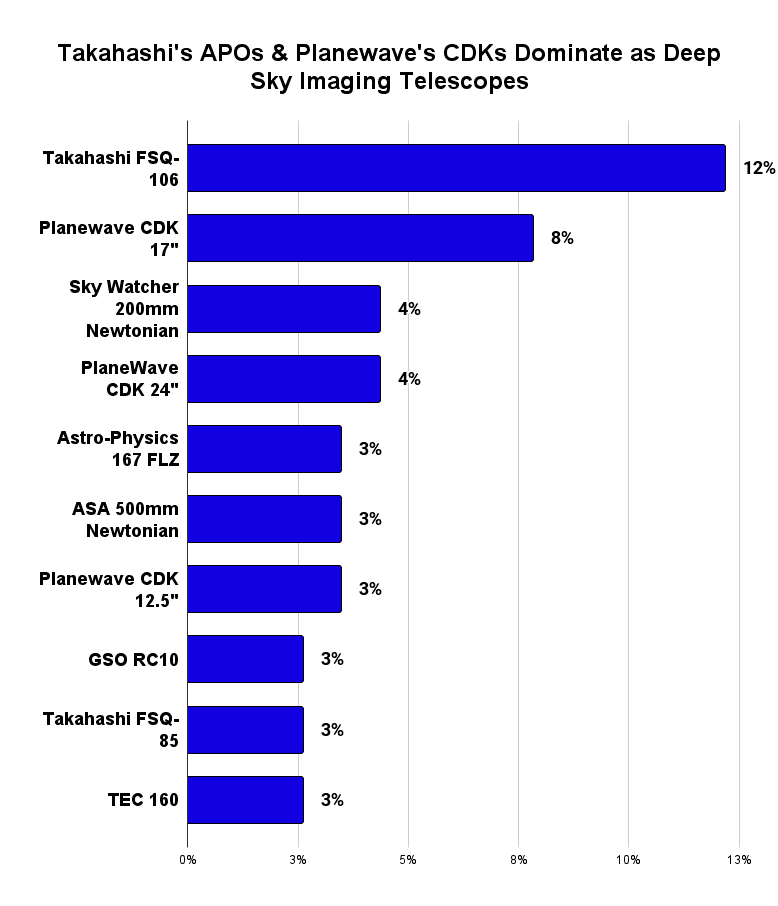
FAQs: Best Deep Space Telescopes
What is the best telescope for deep space viewing?
The data above gives us insight into the best telescopes for deep space imaging, but what makes a good model for observing (i.e. looking through) is actually completely different:
- Astrophotography: A great telescope for imaging can have a relatively low aperture because your camera will track the object you are photographing for a long period to gather enough light for the image.
- Astronomy: However, for viewing you are looking at the object with your eyes through the eyepiece and so you need a high aperture for better light gathering.
This is why for deep sky observing you want a telescope with as high an aperture as you can afford. This will likely be either:
- A dobsonian if you have the space (see the Best 8-inch Dobsonians), or
- A catadioptric (like a Celestron Schmidt-Cassegrain) if you prefer something more compact and have the money
What type of telescope is best for deep space?
For most people:
- Dobsonians are the best telescopes for deep sky astronomy, and
- Apochromatic refractors are the best telescopes for deep space astrophotography.
See more on this above or check out the Best Apochromatic Refractor Telescopes.
What type of telescope is best for viewing galaxies?
Dobsonians are the best telescope type for viewing galaxies but are very large.
Schmidt-Cassegrains are also good and more compact but will cost more.
Can you see deep space with a telescope?
Yes, you can see deep space with a good telescope. You will likely have to spend at least $600 for a telescope that has a high enough aperture to provide these views.
How big of a telescope do you need to see galaxies?
Technically, you can see galaxies like Andromeda with your naked eyes in areas with low light pollution, however having a telescope with at least 6-inch aperture will give you the best chance of good views of galaxies.
What is the best camera for deep space astrophotography?
See our detailed overviews on the best cameras here:
What is the best telescope mount for deep space?
The mount you use will depend on which telescope you are using, mostly because you will need a mount that can comfortably take the weight of your OTA.
See our research on the Best Mounts for Astrophotography.
Conclusion: What’s the Best Telescope for Deep Space Photography?
Overall, we recommend the:
- Takahashi TSA-120– the best apochromatic refractor for astrophotography that provides a balance of performance with low weight
- Sky-Watcher Quattro 200P – the best newtonian astrograph providing a high aperture for a budget price
- William Optics ZenithStar 61 – the best budget telescope for deep space astrophotography, providing ultra-portability
- Celestron RASA 11 – the best Celestron for deep space imaging with the biggest aperture, longest focal length, and fastest focal ratio
Please let us know if you have any questions in the comment below.


